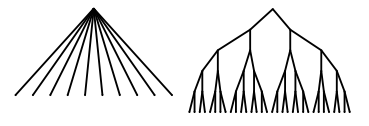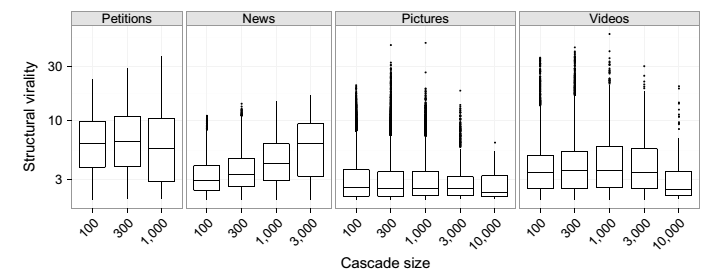When a meme becomes popular, we often say that it has gone “viral”. This word suggests that memes become popular by being particularly infectious. In analogy to epidemics, a particularly viral meme hits a critical threshold where it just won’t die, because each new infection spreads it to even more people. But is this epidemic model actually true?
A paper titled “The Structural Virality of Online Diffusion” puts into question the very idea that popular memes are viral. They point out another mechanism by which memes can become popular: the broadcast. Rather than infecting multiple generations of followers, a meme may become popular simply by infecting one person with a lot of followers.

Figure 1 from the paper. The tree on the left illustrates a broadcast, while the one on the right illustrates viral spreading.
The paper considers a massive amount of Twitter data to determine whether the most popular links are broadcast-like or virus-like. On average, they more resemble broadcasts, but there is a huge amount of variation.
What is structural virality?
For each shared link on Twitter, the authors construct a tree to illustrate its spreading structure. The root of the tree represents the first Twitter account to share the link (that is to say, the root does not follow anyone on Twitter who shared the same link). Each of the other nodes in the tree is assigned a parent based on which tweet they most likely got the link from.
Part of the purpose of the paper is to find a measure for the intuitive concept of “virality”, one which is based not on any knowledge of the mechanism, but based purely on the tree structure. The measure they choose is the Wiener index, which is the average distance between nodes. For a pure broadcast, the structural virality is 2. For a viral meme, the structural virality is proportional to the number of generations in the tree.
How viral are links on Twitter?
The vast majority of shared links on Twitter never get anywhere. 99% of shared links are accounted for by either the root nodes, or by the first generation after the root. Luckily, this study looks at a billion different trees, which allows them to get statistically significant insight into the 0.025% of trees which have at least 100 nodes. They analyze structural virality, comparing trees of different sizes, and of different link types:

Figure 5 from paper. For each link type (petitions, news, images, and videos), the structural virality is shown for different tree (cascade) sizes. The rectangles indicate the middle quartiles, conveying the amount of variation in structural virality.
Summary of observations:
1. Images and videos have median structural virality around 2 to 4, indicating that they are very broadcast-like.
2. Petitions have median structural virality between 7 and 8.
3. Except for news stories, the structural virality is not very strongly correlated with the size of the tree. News stories have a positive correlation between structural virality and tree size.
4. Overall, there is a lot of variance in structural virality.
What does this say about the internet?
At first, it might seem that links become popular by being more infectious, but this is inconsistent with the data. Under such a model, the structural virality should be correlated with tree size, which is only observed in news stories. Furthermore, if infectiousness were the main mechanism, then there would be a critical point beyond which they become like epidemics, leading to a bimodal distribution of popularity. Again, this is not observed.
Instead, they find that the data better fits a model where links are all equally infectious. Their model uses a “scale-free” network, which means that people are more likely to become connected to people who are already well-connected. This leads to a fractal-like network structure. One flaw in the model is that it fails to account for the observed variance in structural virality. Further study is still needed.
These results are pessimistic about the popularity of memes. Rather than getting popular by beating the competition, memes become popular essentially by being lucky enough to catch the attention of a big celebrity.

Leave a Reply